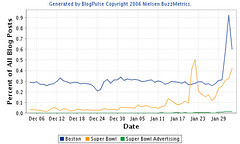My colleague Pete Blackshaw and I are part of a larger team working on Super Bowl buzz analysis. Last week we underscored how ex-Britney Spears beau Kevin Federline has been dominating pre-game buzz. Today Stuart Elliott at the NYTimes has a nice piece about this phenomenon. It is more of a case study in the spirit of his story last week, which was all about how the 30-second spots are just the beginning of an ancillary web of consumer pass-along. The big game now is all about technology, integration and multiplication.
Now, the $2.6 million dollar question: Will the Boston ad prank cannibalize attention around advertising buzz – leading up to, during and after the Super Bowl. Will there be a sour taste in people’s mouths regarding commercially-generated hype? Presuming ancillary buzz is what justifies the high price of 30-second television spots, should advertisers demand reconciliation from networks in situations like this? I think this is where we’ll eventually end up, within a few years, if not sooner. Pete has some good analysis here.
Boy, that Boston ad prank is a major black eye for the marketing and advertising industry.

